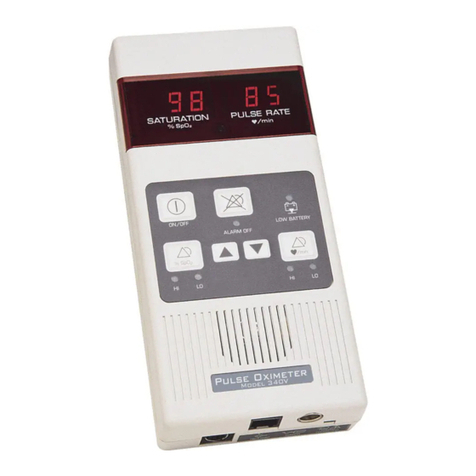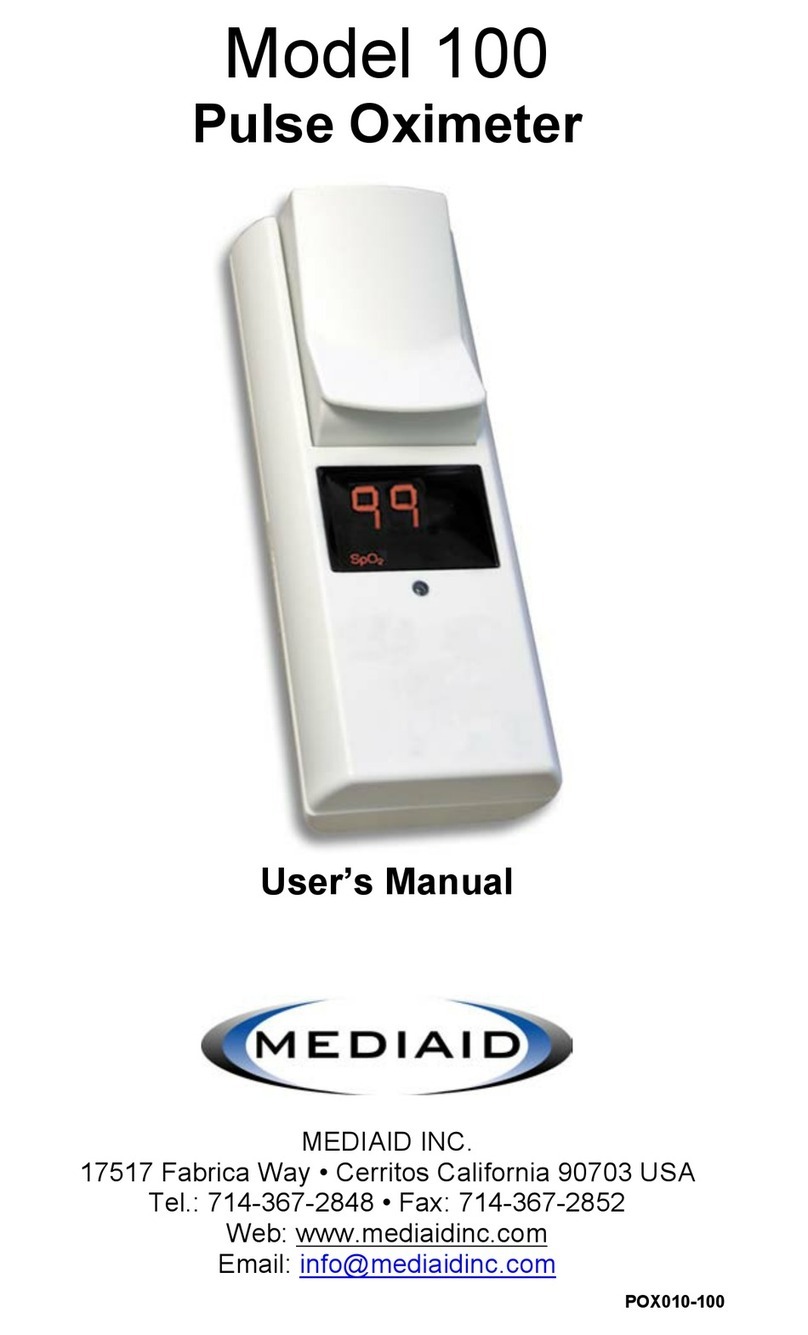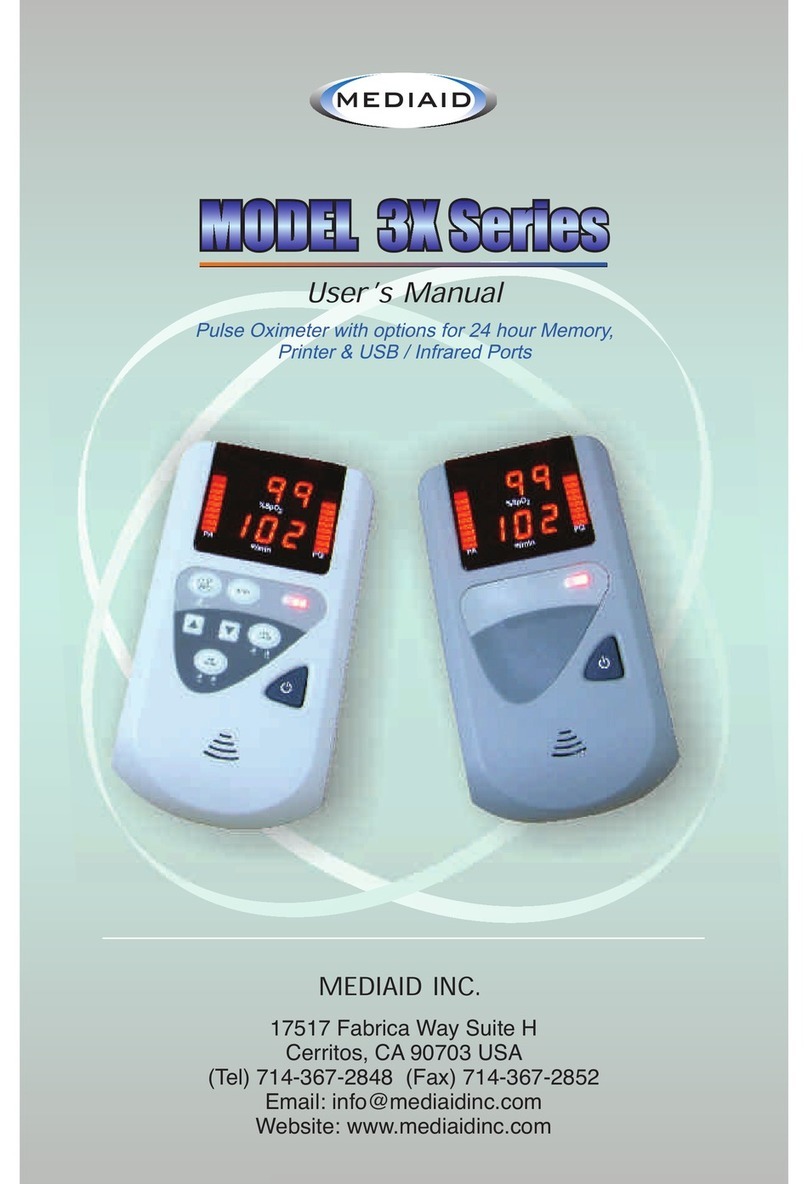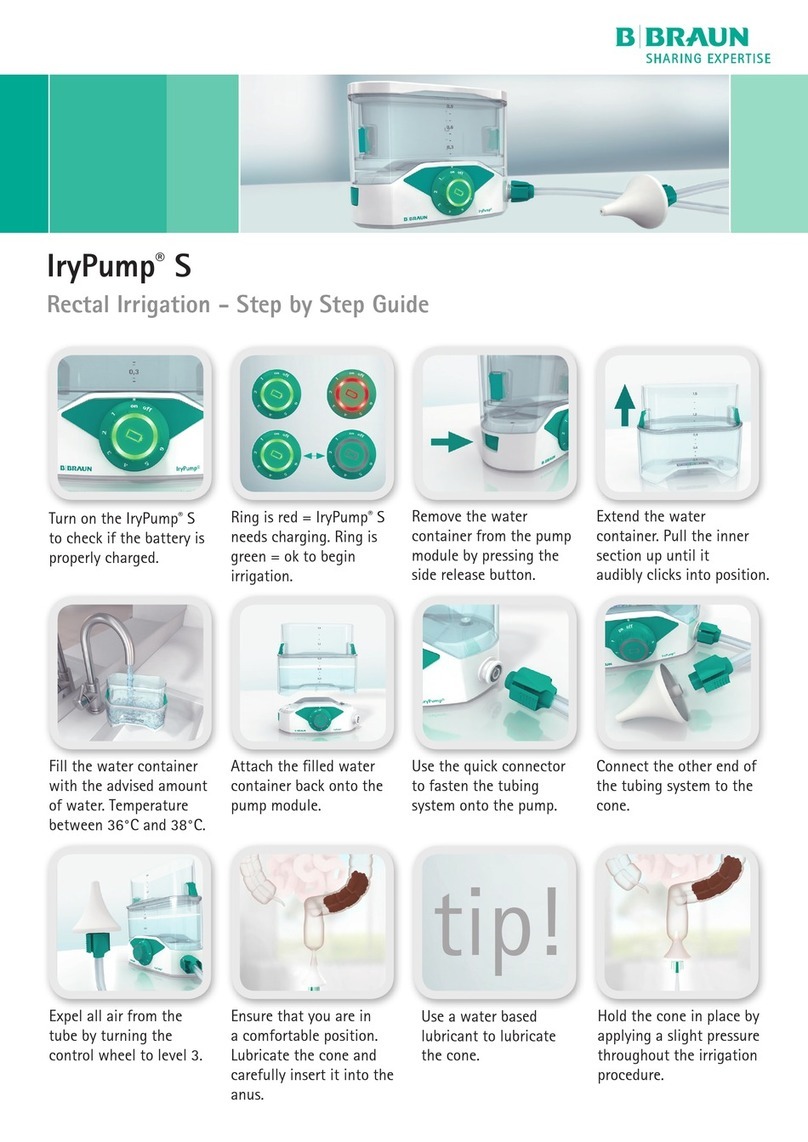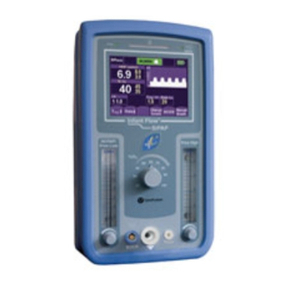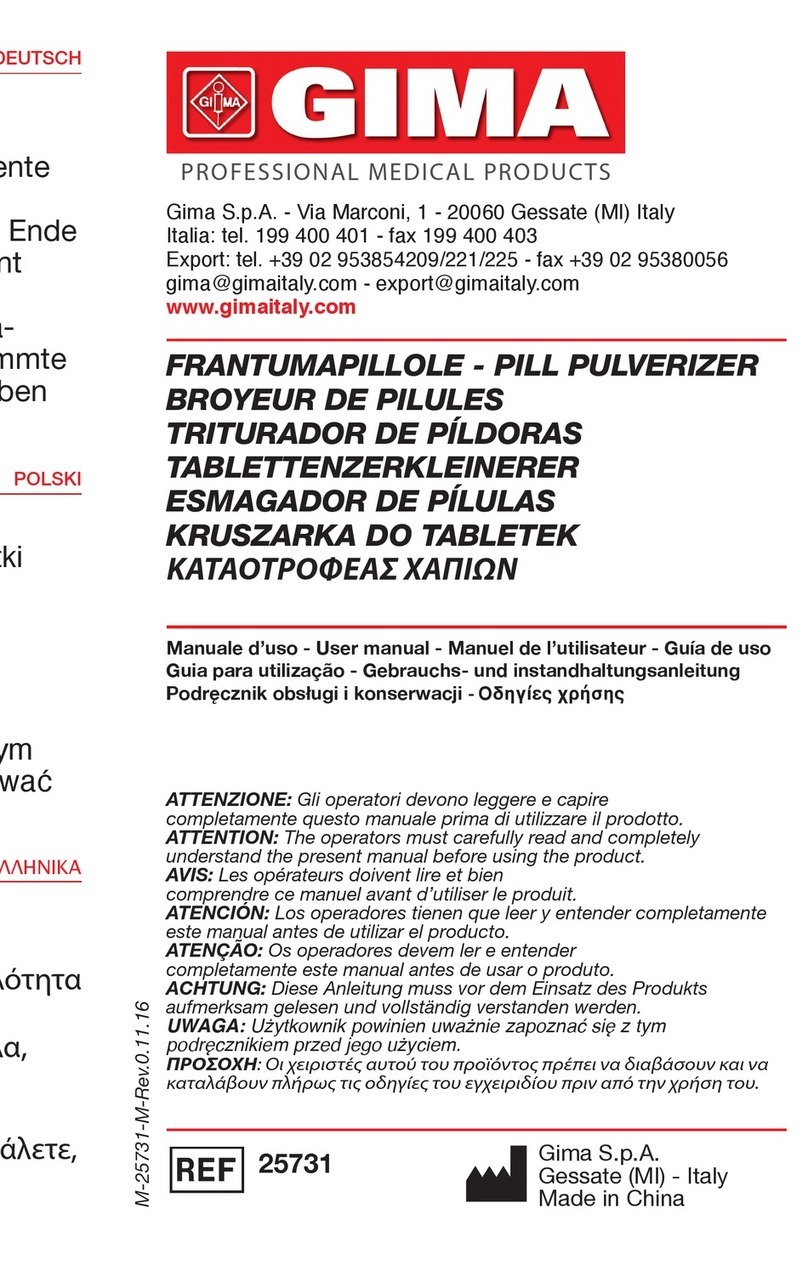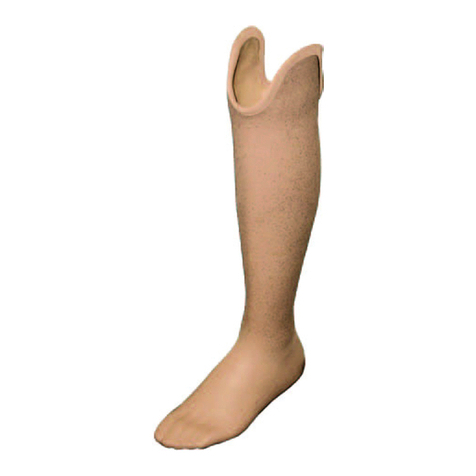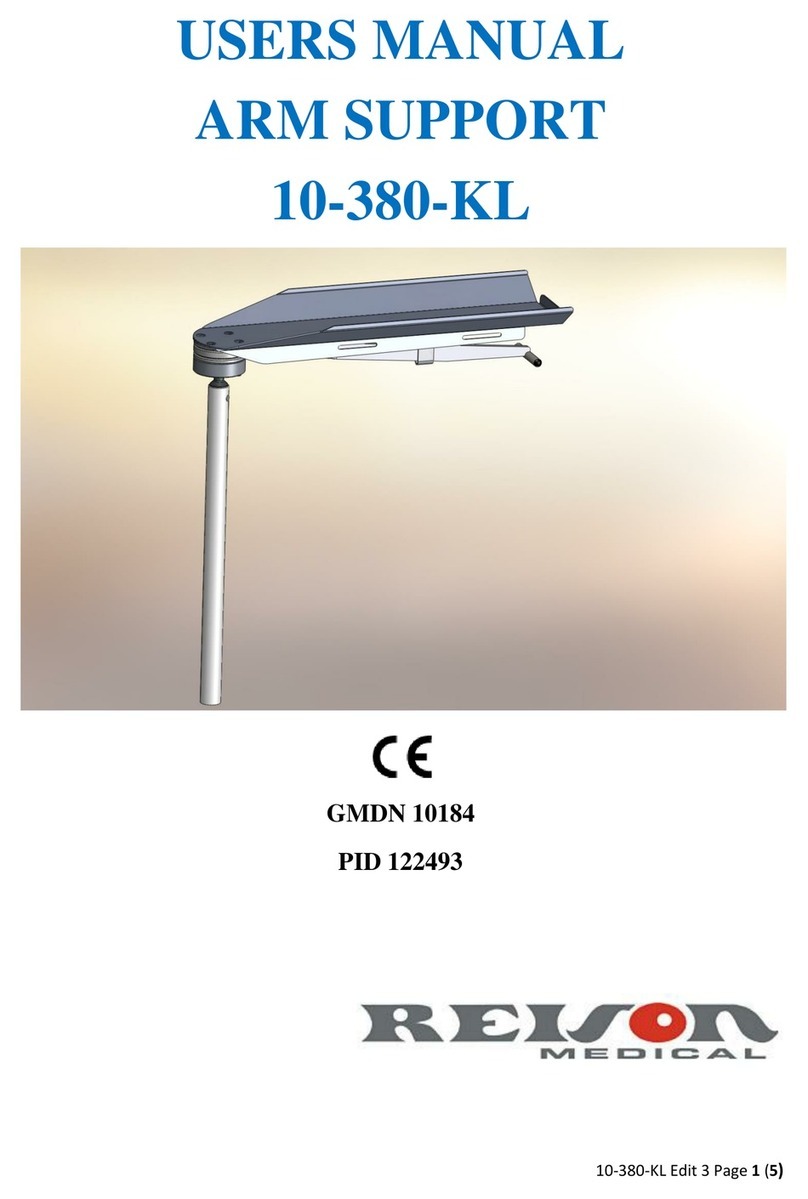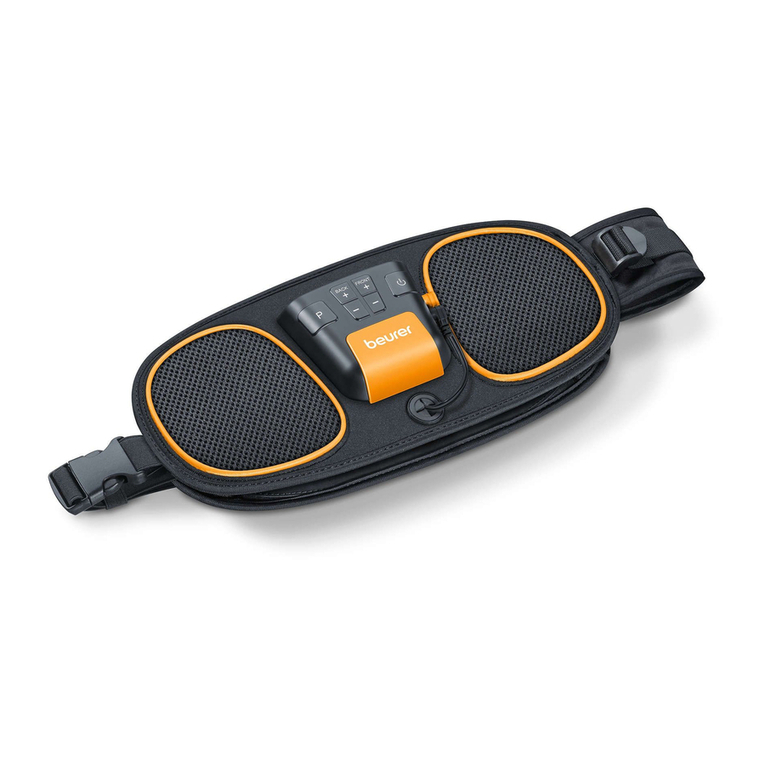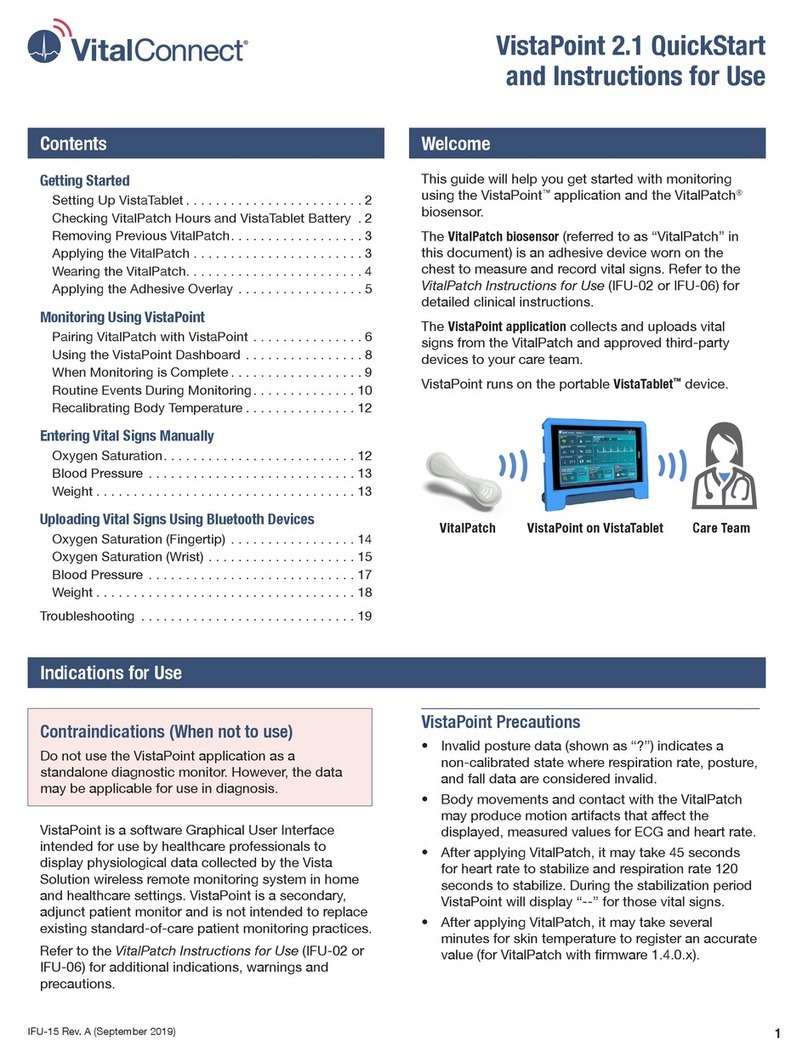MEDIAID 300 Series User manual

Model 300 Series
Pulse Oximeters
User’s Manual
300, 305, 340
MEDIAID INC.
17517 Fabrica Way • Cerritos California 90703 USA
Tel.: 714-367-2848 • Fax: 714-367-2852
Web: www.mediaidinc.com
Email: info@mediaidinc.com
POX010-300


Contents
-Contents 1 -
Contents
Chapter 1: Principle of Operating the Model 300 Series......................1
1.1 Intended Uses ..................................................................... 1
1.2 Principal Features ............................................................... 1
1.3 Modes of Monitoring ............................................................ 2
1.4 Cautions ............................................................................. 2
Chapter 2: Keys, Indicators, & Symbols .................................................5
2.1 Keys & Indicators ................................................................ 5
2.2 Symbols ............................................................................ 12
Chapter 3: Operating the Model 300 Series..........................................13
3.1 Receiving Accurate Readings ............................................ 13
3.2 Power ............................................................................... 14
3.3 Measu ring and D isplay ing Pu lse Ox ime try .......................... 15
3.4 Data Transmission (Model 340) ......................................... 16
3.5 Tests ................................................................................ 18
3.6 Cleaning Instructions......................................................... 22
3.7 Troubleshooting ................................................................ 23
Chapter 4: Equipment Specifications....................................................25
4.1 Oxygen Saturation and Pulse Rate..................................... 25
4.2 Alarms (Model 340 Only) ................................................... 25
4.3 General ............................................................................. 25
4.4 Sensors ............................................................................ 25
4.5 Power Source.................................................................... 26
4.6 Environmental Conditions .................................................. 26
4.7 Equipment Classification ................................................... 26
Chapter 5: Order Information..................................................................27
5.1 Product Information ........................................................... 27
5 .2 Co n ta ct /Cu s to m er S erv ic e In fo rm a ti on .... ... .. .. ... .. .. ... .. .. ... .. . 2 7
Chapter 6: Warranty Information............................................................29
6.1 Applicability of Warranty .................................................... 29
6.2 What is Covered by this Warranty ...................................... 29
6 .3 W ha t M ed ia id I nc . W il l D o to C o rre c t P ro b le ms ... ... .. ... .. .. ... 2 9
6.4 Owner’s Registration ......................................................... 30
6.5 Product Information ........................................................... 30


Principles of Operation of the Model 300 Series
- 1 -
Chapter 1:
Principles of Operation of
the Model 300 Series
The Model 300 Series comprises the following pulse oximeters:
Models 300, 305, & 340.
Before using the pulse oximeter, the user should become
thoroughly familiar with the information in this manual and with all
information included with the sensor.
1.1 Intended Uses
• The Models 300 and 305 are
intended for spot checks.
• The Model 340 is the only pulse
oximeter intended for continuous
monitoring.
1.2 Principal Features
All Models
• The Mediaid Model 300 Series Pulse Oximeters are portable,
lightweight instruments designed to monitor arterial oxygen saturation
non-invasively.
• All models have two bright Light Emitting Diode (LED) displays that give
a constant read-out of oxygen saturation (in %SpO2) and pulse rate in
beats-per-minute (BPM).
• Each machine has a front-panel LED indicator that alerts the user to a
low-battery condition.
• All Model 300 Series Pulse Oximeters perform a functional test at
power-on, and diagnostics tests can be initiated.
• All Mediaid oximetry sensors with RJ12 connectors are compatible with
the Model 300 Series.
• All the pulse oximeters can be powered either by standard electric
power or an internal, rechargeable Nickel-Cadmium (NiCad) battery -
except the Model 300, which is powered solely by six [6] type “AA”
batteries.
WARNING
Do not use the pulse oximeter
as an infant apnea alarm.

Principles of Operation of the Model 300 Series
- 2 -
Model 340
• The Model 340 allows for data transmission through the data port
(when Serial or Analog Cable is plugged in at power-up), while heart
rate and %SpO2are displayed on the Oxygen Saturation and Pulse
Rate displays.
Model 340
• The Model 340 has visual and audible alarms for oxygen saturation and
pulse rate monitoring.
• The Model 340 has an audible tone that sounds with each pulse and
varies with oxygen saturation — falling in pitch with reduced
saturation and rising as saturation increases.
1.3 Modes of Monitoring
All Models
• All models in the Mediaid 300 Series are calibrated to measure the
oxygen saturation (%SpO2) of functional hemoglobin.
• A normal (steady) display indicates the oximeter has received at least
three normal, intelligible pulses during the last 30-second period. The
display will be updated each time a normal pulse has been received.
• A blinking display indicates the continuous presence (30 seconds or
more) of significant patient movement or light-source interference. In
this mode, no normal pulses are being received, and the last reliable
values for %SpO2and pulse rate are displayed. In this mode, %SpO2
monitoring may be adversely affected.
Model 340
• A blinking display with a one-second warning tone every 10 seconds
indicates the continuous presence (60 seconds or more) of significant
patient movement or light-source interference. In this mode, no
normal pulses are being received and %SpO2monitoring may be
adversely affected.
1.4. Cautions
• Before using the equipment, the operator should be thoroughly familiar
with the information in the User’s Manual and all accompanying
documents.
• Federal (U.S.A.) law restricts this device to use by — or on the order of
— a physician.

Principles of Operation of the Model 300 Series
- 3 -
• The instrument should not be used in the presence of anesthetics or
flammable agents.
• Do not allow any liquid to penetrate the instrument’s interior.
• The Model 300 Series Pulse Oximeters are designed to operate in
normal, ambient light conditions.
•Do not use near Magnetic Resonance Imaging equipment.
• To avoid potential effects of electromagnetic interference; maintain a
distance of at least 15 cm. (6") between the oximeter and other
devices. Also, maintain a distance of at least 20 cm. (8") between the
Mediaid wall adaptor and other devices.
• When used with other equipment, such as a defibrillator, the accuracy
of pulse oximetry readings may be affected.
• In case of abnormal conditions during instrument operation, appropriate
measures (such as powering off instruments) should be taken to
ensure patient safety.
• The user should NOT attempt to modify or repair the instrument.
• This device complies with Electromagnetic Compatibility standards
EN55011 and EN60601-1-2. If the user experiences interference
problems, move the unit away from other EMC emitting equipment.
• Dispose of this device according to hospital and/or governmental
regulations.

Principe d’Utilisation
- 4 -

Keys, Indicators & Symbols
- 5 -
Chapter 2:
Keys, Indicators & Symbols
2.1 Keys and Indicators

Keys, Indicators & Symbols
- 6 -
A. Power On/Off Key
All Models
The unit is powered on with a short depression of the POWER
ON/OFF KEY. A one-second display and indicator test is
performed automatically, and all Light Emitting Diodes (LEDs) are
illuminated. Carefully observe the Saturation and Pulse Rate LED
displays at the top of the oximeter for proper operation of all segments of
the display; a nonfunctioning segment will result in an incomplete
numeral and possible erroneous reading. A long depression of the
POWER ON/OFF KEY will initiate Internal Confidence and Self Diagnostics
tests (See Section 3.5 “Tests”).
B. Oxygen Saturation Display
All Models
Whenever the pulse oximeter receives at least three (3) pulses during
a 30-second period, the left LED shows the patient’s %SpO2levels. The
display is updated with every normal pulse. A blinking display signals
that %SpO2monitoring may be adversely affected, and indicates the
continuous presence (30 seconds or more) of significant patient
movement or light-source interference.
C. Pulse Rate Display
All Models
Whenever the pulse oximeter receives at least three (3) pulses during a
30-second period, the right, three-digit LED displays the patient’s heart
rate in beats-per-minute (BPM). Any blinking display signals that
pulse rate monitoring may be adversely affected, and indicates the
continuous presence (30 seconds or more) of significant patient
movement or light-source interference.

Keys, Indicators & Symbols
- 7 -
D. Visual Pulse Indicator
All Models
As soon as a pulse is found, the heartbeat is indicated by the small
green LED beneath the LED display window. The VISUAL PULSE
INDICATOR simultaneously flashes with the patient’s pulse. It will typically
begin to flash a few seconds before numerical values for oxygen
saturation and pulse rate are shown.
E. Low Battery Indicator
All Models
The LOW BATTERY INDICATOR will illuminate when the
battery is near depletion, prompting the user to suspend
operation of the unit and change or recharge the battery (using the
method described in Section 3 “Power”). The oximeter will automatically
power off shortly after low-battery indication. The acronym bAt LO will be
displayed if power-on is attempted during a low-battery condition.
F. Sensor Cable Connection
All Models
All Mediaid pulse oximetry sensors with RJ12
connectors are compatible with the Model 300 Series. To connect a
sensor to the oximeter, align the plug with the jack on the oximeter and
insert it gently until an audible “click” is heard — indicating that the plug
tab is latched in place. To remove, squeeze the locking tab on the plug
and slide the plug out of the jack. Always route cords in such a way as to
prevent accidental tripping and subsequent damage to the oximeter.

Keys, Indicators & Symbols
- 8 -
G. Power Connection
Model 305, Model 340
For electric power, plug the adaptor into the pulse oximeter’s
POWER CONNECTION, and then plug the other end of the
adaptor into a standard electrical outlet. All Mediaid Pulse Oximeters
(except for the Model 300) were designed to be used with the
adaptor provided by Mediaid Inc. at the time of purchase.
H. Power Indicator
Model 305, Model 340
The green LED - located on the bottom of the oximeter adjacent to the
POWER CONNECTION - will illuminate when electric power is connected.
I. Data Port
Model 340
The DATA PORT is used for serial and analog output. To
eliminate risk of shock, take care not to touch the DATA
PORT 8-pin Connector and the patient simultaneously. The DATA PORT
should be used only for connection to equipment that complies with
CSA/IEC/UL601-1. Refer to Section 3 for information on Data
Transmission.
J. Alarm Off Key
Model 340
A short depression of this key silences the alarm for a
period of 60 seconds. A long, three-second depression of the ALARM OFF
KEY will completely disable the audible alarm. The LED display will show
AL OFF, the ALARM OFF INDICATOR will begin to flash, and the oximeter
will revert to normal monitoring. Silenced alarms can be reactivated by a
short depression of the ALARM OFF KEY. Disabled alarms are reactivated
by a long depression of the ALARM OFF KEY.

Keys, Indicators & Symbols
- 9 -
K. Alarm Off Indicator
Model 340
The ALARM OFF INDICATOR will illuminate and remain on constantly when
audible alarms are silenced, and will flash when audible alarms are
disabled.
L. Oxygen Saturation Alarm Key
Model 340
Short depressions of the OXYGEN SATURATION ALARM KEY will
toggle the display between the high and low alarm settings,
as shown by the HI/LO ALARM INDICATORS. These alarm settings can be
adjusted with the INCREMENT and DECREMENT keys. The alarm
settings will be retained in memory until reset by the user. Exception:
When the low-saturation alarm is set below 80%, it will return to 80% at
the next power-up. The saturation alarm production settings are: High
100% and Low 85%. The high-saturation alarm can be disabled by
setting it at 100%. The unit reverts to normal monitoring after a five-
second period of key inactivity.
M. Pulse Rate Alarm Key
Model 340
Short depressions of the PULSE RATE ALARM KEY will toggle
the display between the high and low alarm settings as
shown by the indicators (HI and LO) below the key. These alarm settings
can be adjusted via the and keys. Alarm settings will be retained in
memory until the user changes them. The pulse-rate alarm production
settings are: High 140 BPM and Low 50 BPM . The
display reverts to normal patient monitoring after a five-second period of
key inactivity.

Keys, Indicators & Symbols
- 10 -
N. Increment & Decrement Key
Model 340
The pulse-tone volumes can be adjusted using
the INCREMENT & DECREMENT Keys. There
are three (3) levels of audible (pulse) tone volume, and “off.” The pulse
tone volume can be increased with the key, and decreased or
silenced with the key. Alarm levels are also adjusted with these keys.
O. Visual Hi/Lo Alarm Indicators
Model 340
Located beneath the OXYGEN SATURATION ALARM and PULSE RATE ALARM
KEYS, these indicators illuminate when the patient’s oxygen saturation or
pulse rate reaches the preset high or low alarm settings. In order to set
alarms, the appropriate indicator must be illuminated.
Additional Features
Audible Oxygen Saturation Indicator
Model 340
A varying pitch of the audible tone signals a change in the %SpO2level -
a falling pitch indicates a decreasing %SpO2level.
AUDIBLE PULSE RATE INDICATOR
Model 340
A beeping audible tone signals the heartbeat.
AUDIBLE ALARM INDICATORS
Model 340
The alarm tone is a fixed pitch, and the volume cannot be adjusted.
Alarm conditions are generated only when a pulse has been detected.
Alarm tones are automatically silenced when the alarm condition goes
away. HIGH PRIORITY alarm tones sound continuously at the highest
frequency and highest volume. HIGH PRIORITY alarms are caused by
conditions such as: low and high oxygen saturation and pulse rate; no

Keys, Indicators & Symbols
- 11 -
pulse; excessive ambient light, and other error conditions. MEDIUM
PRIORITY alarm tones sound for 0.75 (∫) seconds every five (5) seconds at
the highest frequency and highest volume. MEDIUM PRIORITY alarms are
cause by measuring problems such as disconnected sensor, too thin or
thick tissue, or a faulty sensor. LOW PRIORITY alarm tones sound for one
(1) second every 10 seconds at the lowest frequency and highest
volume. LOW PRIORITY alarms are caused by excessive patient movement
or patient arrhythmia.
Battery Compartment (& Battery Polarity )
Back of Model 300
The compartment houses the six (6) type “AA” batteries necessary to
power the Model 300. Be sure to correctly install the batteries by
following the polarity indicated inside the compartment.

Keys, Indicators & Symbols
- 12 -
2.2 Symbols
Symbol
Definition
%SpO2
Oxygen Saturation Percentage
Heart Beats Per Minute (BPM)
Power On/Off
Alarm Off
Low Battery Indicator
Oxygen Saturation Alarm
Pulse Rate Alarm
Hi/Lo Alarm Indicator
Increment Key
Decrement Key
Data Port
Sensor Cable Connector
Power Connection
Attention: Consult Accompanying Documents
Non-anesthetic Proof
Type BF Applied Part
Battery Polarity

Operating the Model 300 Series
- 13 -
Chapter 3:
Operating the Model 300
Series
3.1 Receiving Accurate Readings
To prevent faulty readings and sensor complications:
• do not apply the sensor to anything but a well-perfused extremity.
• do not place the sensor on extremities with blood pressure cuffs or with
arterial or venous catheters.
• avoid extremity positions that may compress venous return.
• keep sensors at heart level whenever possible.
• fit sensors comfortably without constricting or compressing digits.
• do not restrict circulation with elastic tape used to secure sensors.
• trim long fingernails if necessary.
• remove artificial nails and thick
nail polishes if necessary.
• check for intravascular dyes,
which may affect pulse oximeter
readings.
• turn off very bright lights, such as
xenon lamps, if they interfere
with sensor functioning. In
cases where such lights are
unavoidable, cover the sensor
site with an opaque material.
• route sensor cords carefully.
• avoid applying excessive tension
to the sensor or sensor cable.
• consider conditions affecting the
hemoglobin dissociation curve
when interpreting pulse
oximeter readings.
• keep patient movement to a
minimum.
WARNING
To ensure personal safety and
proper operation of the
oximeter, the user should
adhere to all directions,
information, and cautions
stipulated within this document.
WARNING
In order to obtain accurate
pulse oximetry readings, an
appropriate pulse oximeter and
sensor need to be chosen
according to the intended use.
All instructions stated within
this manual and included with
each sensor should be
followed.

Operating the Model 300 Series
- 14 -
3.2 Power
3.2.1 Model 300
The Model 300 is powered solely
by six (6) type “AA” alkaline
batteries. The instrument will
operate for approximately 16 hours
(approximately 2,000 spot checks)
before the LOW BATTERY INDICATOR
signals that the batteries need to
be replaced.
3.2.2 Model 305, Model 340
Both these pulse oximeters can be powered by either a power adaptor or
the internal, rechargeable NiCad battery. Battery operation alone will
provide the oximeter with approximately 12 hours of continuous
operation. To charge the internal NiCad battery, connect the Mediaid
power adaptor to the POWER CONNECTION located at the bottom of the
oximeter. Then, plug the adaptor into an appropriately rated electrical
outlet. The green POWER INDICATOR will illuminate. Once electric power is
applied, the battery will charge regardless of the operational state of the
oximeter.
NOTE
Remove the batteries prior to
storage if the oximeter is not
likely to be used for an
extended period of time.
WARNING
All Mediaid Pulse Oximeters (except for the Model 300) were
designed to be used with the power adaptor provided by Mediaid
Inc. at the time of purchase. The use of any other adaptor may
damage the oximeter and will void the Mediaid Inc. Warranty.
Refer to the product number of the power adaptor when
reordering a new adaptor. Include the serial number of the unit as
this allows Mediaid Inc. to determine the adaptor needed. Also,
avoid excess tension on the adaptor cable for safe and continuous
operation.

Operating the Model 300 Series
- 15 -
3.3 Measuring and Displaying Pulse Oximetry
3.3.1 Spot-Check Pulse Oximetry
· Choose an appropriate pulse
oximeter and sensor according
to the intended use.
· Place the sensor according to the
instructions included with each
sensor.
·Connect the sensor to the pulse
oximeter with the SENSOR CABLE
CONNECTION.
· Follow all guidelines to prevent
faulty readings, and oximeter or
sensor complications.
· Power on the unit with the POWER
ON/OFF KEY.
· Check that all LEDs illuminate
during the Power-Up Test.
· Monitor the flashing of the VISUAL
PULSE INDICATOR.
· Read patient’s oxygen saturation
level and pulse rate from the
two LED displays.
3.3.2 Continuous Monitoring Pulse Oximetry
Model 340
· Choose an appropriate sensor.
·Place the sensor according to the
instructions included with each
sensor.
· Connect the sensor to the pulse
oximeter with the SENSOR CABLE
CONNECTION.
· Follow all guidelines to prevent
faulty readings, and oximeter or
sensor complications.
· Power on the unit with the
POWER ON/OFF KEY.
NOTE
The unit powers off
automatically when a pulse
search is unsuccessful
while operating on battery
power.
WARNING
Patient movement, light-
source interference, or any
other disturbing causes that
occur for more than 30
seconds are displayed by a
blinking display. During this
period, pulse oximeter
readings can be adversely
affected.
WARNING
Models 300 and 305 have
no audible alarms. Each
model is intended for use by
an attending clinician and
should not be used in
situations where alarms are
required.

Operating the Model 300 Series
- 16 -
· Check that all LEDs illuminate during the Power-Up Test.
· Monitor the flashing of the VISUAL PULSE INDICATOR.
· Read the patient’s oxygen saturation level and pulse rate from the two
LED displays.
· Listen to the AUDIBLE OXYGEN SATURATION and PULSE RATE INDICATOR.
· Adjust the tone with the INCREMENT and DECREMENT Keys.
· Set the VISUAL and AUDIBLE ALARMS to the desired level with the
INCREMENT and DECREMENT KEYS after the OXYGEN SATURATION ALARM
or PULSE RATE ALARM KEYS have been selected.
· Read the alarm settings with the HI/LO ALARM INDICATOR.
· Quell an alarm with the ALARM OFF KEY.
· Reactivate silenced alarms with the ALARM OFF KEY.
3.4 Data Transmission
Model 340
Serial and analog data can be
communicated through the data
port to a peripheral device. Analog
output of oxygen saturation (0-100
%SpO2) and pulse rate (0-250 BPM) are each transmitted on a scale of
0.0 to 1.0V. Serial output of oxygen saturation (0-100 %SpO2) and pulse
rate (0-250 BPM) are transmitted once per second in a data packet. For
tests regarding data transmission and the data port, please refer to the
Test section.
2. Serial Line (RX)
3. Pulse Rate Analog Output
6. Saturation Analog Output
7. Ground Signal Common
8. Serial Line (TX)
3.4.1. Serial Data Transmission
· Serial data can be transmitted with a Mediaid Serial Cable.
· Transmission speed is 9600 baud.
· The data field is 8 bits, one stop bit, no parity.
WARNING
Do not silence the audible
alarms or decrease their
volume if patient safety could
be compromised.
This manual suits for next models
6
Table of contents
Other MEDIAID Medical Equipment manuals
Popular Medical Equipment manuals by other brands
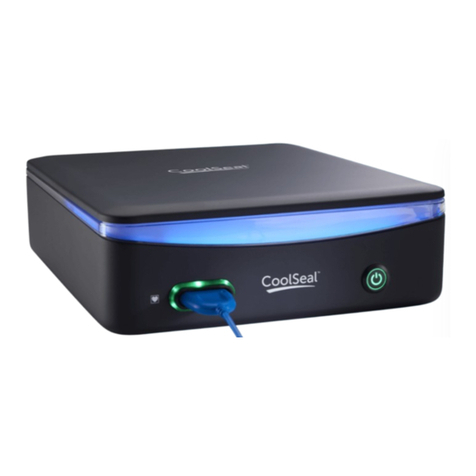
Bolder Surgical
Bolder Surgical CoolSeal GENERATOR user guide

Interior Health
Interior Health Respimat How to use
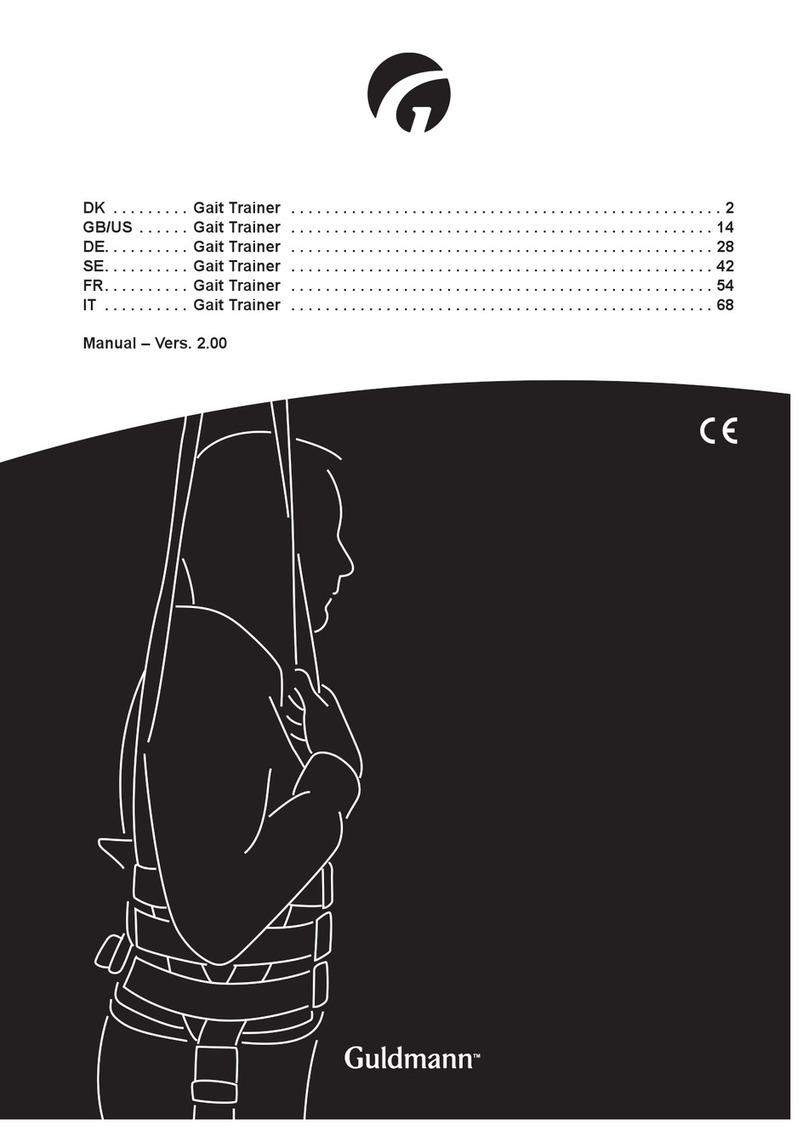
Guldmann
Guldmann 2832 Series manual

Otto Bock
Otto Bock C-Leg Prosthetic System Instructions for use
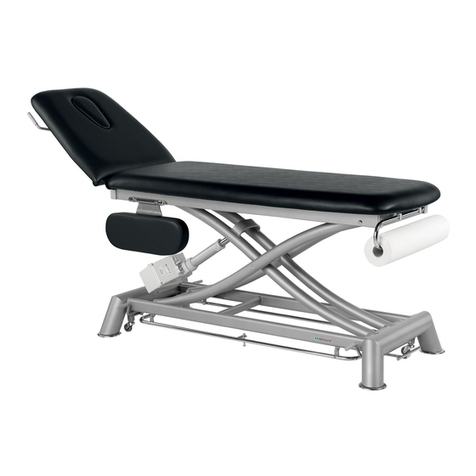
ECOPOSTURAL
ECOPOSTURAL C7934 instructions
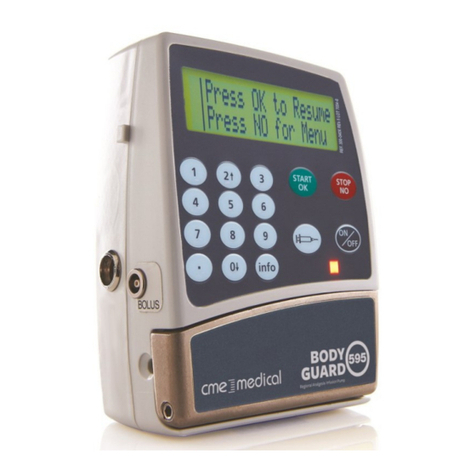
CME Medical
CME Medical BodyGuard 595 Operation manual
